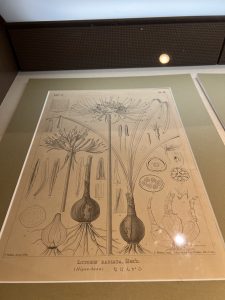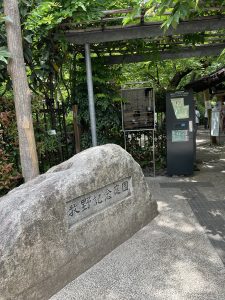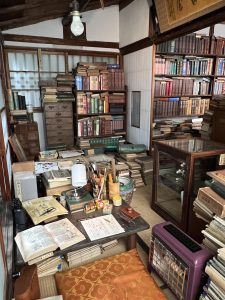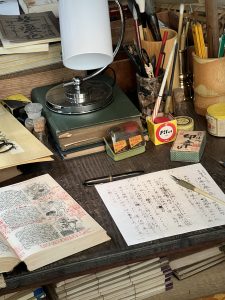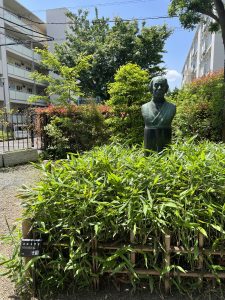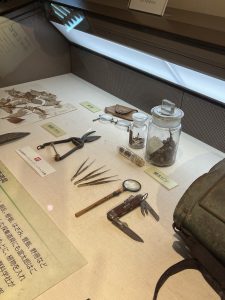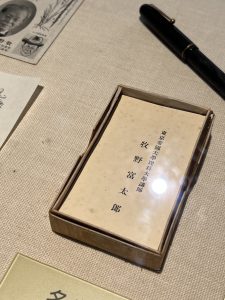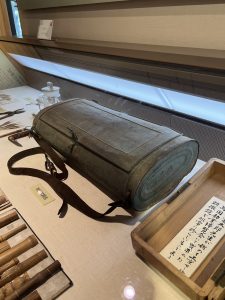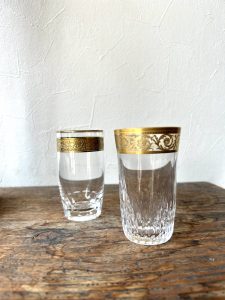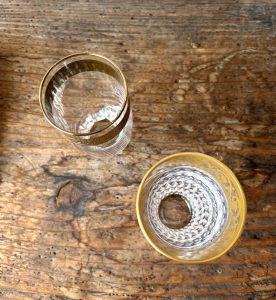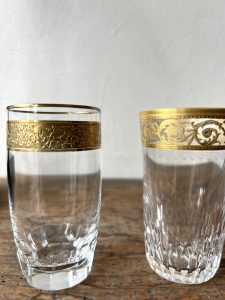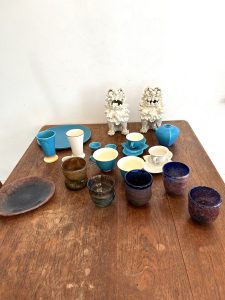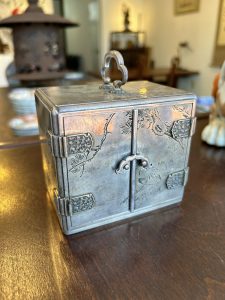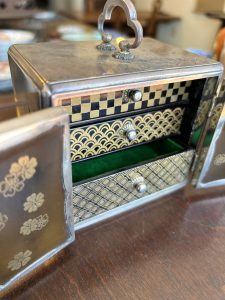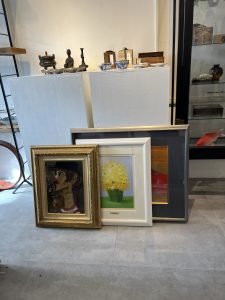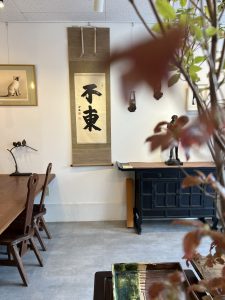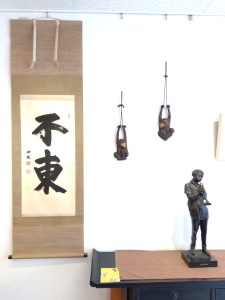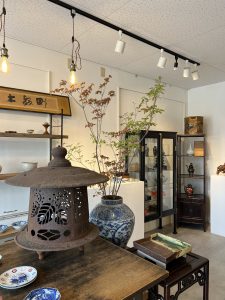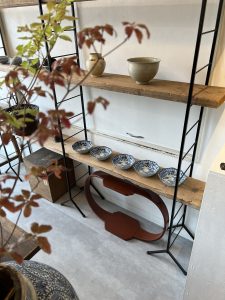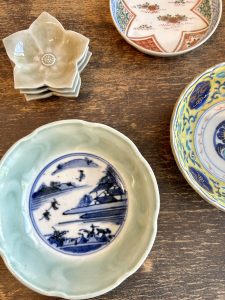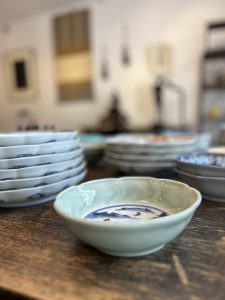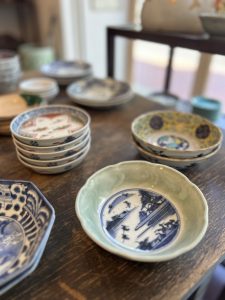初期伊万里の愛らしさ(愛知県名古屋市千種区姫池通 骨董買取 古美術風光舎)
2023.09.30
皆さまこんにちは。スタッフHでございます。
昨夜は中秋の名月。天気にも恵まれ、まさに‘まんまるお月様’を見ることができましたね。建物の間から姿を見せた時の大きなオレンジ色の満月は迫力がありました。
月は高さによって色が異なるそうです。大気で月の光が散乱するため、低い所では赤やオレンジ、高くなると黄色っぽくなり、天頂近くなると白っぽくなるのだそうです。お月見については後で綴らせていただくとして、本日の気になる作品は、愛らしい姿でいつも和ませてくれるこちらの初期伊万里の器(お猪口?)です。
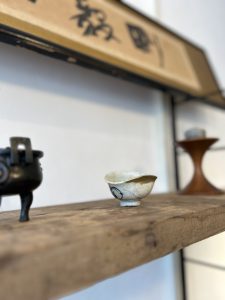
どの角度から見ても愛らしいので、モデルのように回転させてみました。
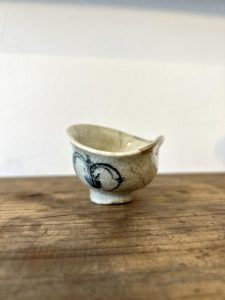
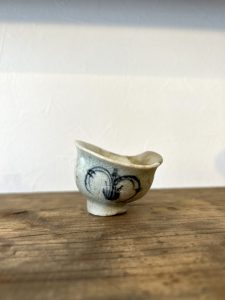
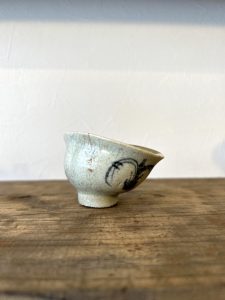
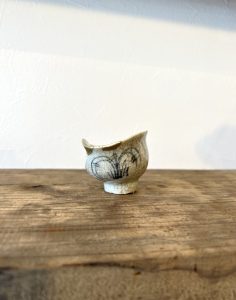
どうでしょう。この首をかしげたような、真っすぐ立とうと頑張っているような愛らしさ。
少しお勉強しましたのでお付き合いください。伊万里焼は朝鮮半島から来た人々の手で、1610年代に有田町で作り始められた日本最初の磁器です。泉山で原料になる陶石が発見されると、有田町東部に窯場の中心が移りました。約1610年から1640年ごろに作れらたものを初期伊万里といいます。文様構成は中国明時代末期のものを模倣しており、日本独自のスタイルを求めて試行錯誤していた時期です。素焼きをせずに釉薬をかけて焼いたものが多く、焼成中に歪んだり割れたりすることもあったとのこと。技術的には未完成ですが、素朴で味わい深い絵付けも初期伊万里の特徴の一つです。
実際に目にし、触れてみるとその魅力に納得します。見ていると脳の奥の方をくすぐられる感じです。表現が分かりづらすぎますね。金繕いをされて今日までこのなんともいえないバランスを保ちながら、風光舎までたどり着いたのかと思うとジーンときてしまいます。
そしてその時代の人々も同じ月を見ていたのだなと思うと心強く感じるのはなぜでしょうか。さて突然お月見の話に戻りますが、古来から月を愛でる風習は日本にもありましたが、十五夜のお月見は平安時代に中国から日本へ伝わり、貴族の間に広がっていきました。その後庶民へと広がり、魔除けとなるススキや、月に見立てたお団子を供え、お米が無事に収穫できたことに感謝し、次の年の豊作を祈願する行事となっていきました。
お月見の発祥の地である中国の文献によると、周の時代から歴代の帝王が「春分に太陽をまつり、夏至に大地をまつり、秋分に月をまつり、冬至に空をまつる」という習俗があったようです。
中国では「中秋節」と呼ばれ、春節に次いで伝統的な祝日です。中国の中秋節は家族の再会の時間でもあり、人々は共に食事をし、燈籠に火をともして祝います。
そしてなんと言っても「月餅」は欠かせません。月餅は団円(円満)を象徴し、中秋節に必ず食べなければならないものです。月餅の他にはスイカなどの果物を食べ、家族の幸福を祈ります。
月餅は月を模して作られるため、やはり円柱型やドーム型が基本ですが、広州式、蘇州式、北京式、雲南式など地域によって形も変わります。更に色々な店が独自の月餅を販売します。世界的に有名な珈琲店スターバックスも毎年この時期に月餅を販売します。幸運にも頂くことができました。
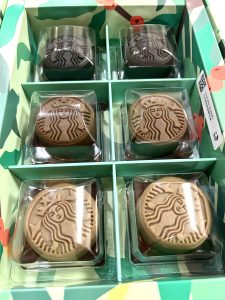
家族や身近な人たちに感謝しつつ、ありがたく頂きます。
それでは、またお会いしましょう。
Hello everyone. This is Staff H.
Last night was the harvest moon of mid-autumn. We were blessed with fine weather and were able to see the full moon. The big orange full moon was very powerful when it appeared between the buildings.
The moon is said to have different colors depending on its height. Because the moon’s light is scattered by the atmosphere, it is said to be reddish-orange at lower altitudes, yellowish at higher altitudes, and whitish when it is near its zenith. I will write more about moon viewing later, but today’s interesting piece is this lovely early Imari vessel (or is it a boar’s mouth?). It is a lovely early Imari vessel (boar’s mouth?).
It looks lovely from any angle, so I rotated it like a model.
What do you think? It looks like it is tilting its head and trying hard to stand up straight.
I have learned a little bit about Imariyaki, so please bear with me. Imariyaki was the first porcelain in Japan, made by people from the Korean Peninsula and started in Arita in the 1610s. After the discovery of pottery stones in Izumiyama, the center of the kiln moved to the eastern part of Arita. The porcelain produced from about 1610 to 1640 is called early Imari. The pattern structure was imitated from the late Ming Dynasty in China, and it was a period of trial and error in search of a uniquely Japanese style. Many pieces were glazed without being fired unglazed, and they were sometimes distorted or cracked during firing. Although technically unfinished, the rustic and tasteful painting is one of the characteristics of early Imari.
When you actually see and touch them, you will be convinced of their charm. When you look at them, you feel a tickling in the back of your brain. It is hard to understand the expression, isn’t it? It makes me feel a little giddy to think that it was mended with gold and kept this indescribable balance until today, and reached to Fumikosha.
And why is it so reassuring to think that the people of that era were also watching the same moon? The custom of moon-viewing has existed in Japan since ancient times, but the custom of moon-viewing on the night of the fifteenth day of the month was introduced to Japan from China during the Heian period (794-1185) and spread among the aristocracy. Later, the custom spread to the common people, who offered silver grass to ward off evil spirits and dumplings resembling the moon to express gratitude for a successful rice harvest and pray for a bountiful harvest in the following year.
According to Chinese literature, the birthplace of otsukimi, since the Zhou dynasty, emperors of successive dynasties had the custom of “worshipping the sun at the spring equinox, the earth at the summer solstice, the moon at the autumn equinox, and the sky at the winter solstice.
In China, it is called “Mid-Autumn Festival” and is the second most traditional holiday after the Spring Festival. The Chinese Mid-Autumn Festival is also a time for family reunions, and people celebrate by eating together and lighting lanterns.
The most important part of the festival is the mooncake. Mooncakes symbolize unity and are a must-eat during the Mid-Autumn Festival. In addition to mooncakes, watermelons and other fruits are eaten to pray for the happiness of the family.
Since mooncakes are made to resemble the moon, they are usually cylindrical or dome-shaped, but the shape varies depending on the region, such as Guangzhou, Suzhou, Beijing, and Yunnan. In addition, various stores sell their own unique mooncakes. The world-famous coffee shop Starbucks also sells mooncakes every year during this season. I was lucky enough to have one.
I am grateful to my family and those close to me, and I eat them gratefully.
I hope to see you again soon.
*******************
ご実家の整理やお片付けなどをされている方のご相談などが多くございます。
お片付けなどくれぐれもご無理のないようになさってくださいませ。
風光舎では古美術品や骨董品の他にも絵画や宝石、趣味のお品など様々なジャンルのものを買受しております。
お片付けをされていて、こういうものでもいいのかしらと迷われているものでも、どうぞお気軽にご相談下さいませ。
また風光舎は、出張買取も強化しております。ご近所はもちろん、愛知県内、岐阜県、三重県その他の県へも出張いたします。
まずは、お電話お待ちしております。
愛知県名古屋市千種区姫池通
骨董 買取【古美術 風光舎 名古屋店】
TEL052(734)8444
10:00-17:00 OPEN
#出張買取#骨董#古美術#骨董品#絵画#版画#茶道具#刀剣#彫刻

